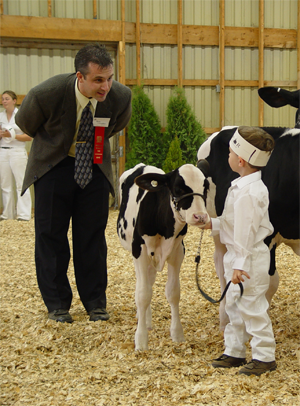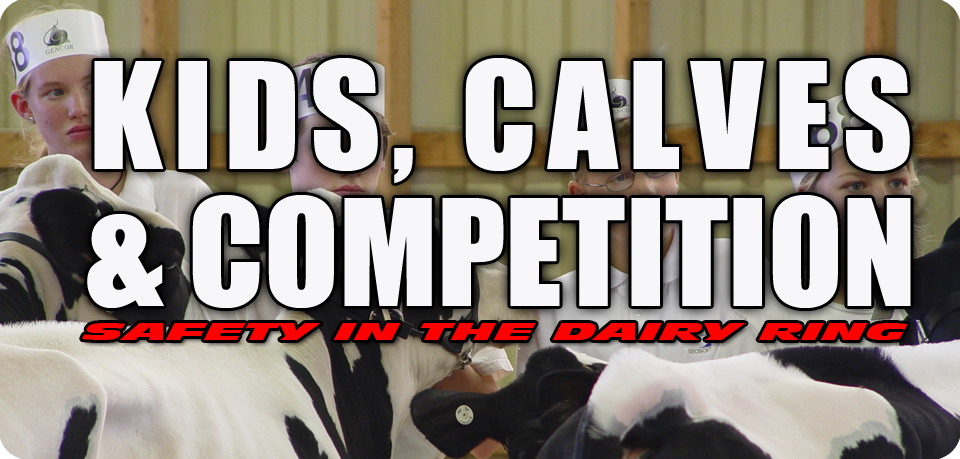 One of the outstanding benefits of living on a dairy farm is that it provides the opportunity to learn how to compete in the dairy ring. Working with dairy animals improves physical fitness, coordination, self-discipline and teamwork, but these beneficial activities can also put participants at risk for injury.
One of the outstanding benefits of living on a dairy farm is that it provides the opportunity to learn how to compete in the dairy ring. Working with dairy animals improves physical fitness, coordination, self-discipline and teamwork, but these beneficial activities can also put participants at risk for injury.
Show-related injuries are preventable. It is a matter of protecting bodies, while they are still growing and just beginning to understand the skills involved in working with animals. Unlike sports such as baseball or hockey where flying objects can cause injuries to the face, the danger in the show ring most often lies in the child’s awareness of the living, and sometimes unpredictable, animal at the end of the lead.
Training of both the child and the animal is the key to avoiding injuries to both participants. Of course, it is up to the adults in charge to make sure that youth participating in the events are safe from foreseeable harm.
Dairy Show Injury Prevention Tips
- Dress participants in appropriate protective equipment. Most sports teams require participants to have specific equipment that is the proper size and adjusted to each athlete. We should do the same for young cattle show persons. Footwear that can withstand tromping on and that is safe from slipping in wet, muddy or messy conditions. Steel toed work boots are the safest choice. Flip flops, clogs and bare feet are strictly unacceptable when working with cattle. If proper protective equipment isn’t available, it is NOT alright to go ahead. It teaches two incorrect things: a- the rules don`t count b- rules can be broken.
- Proper halter size. A halter that is too big is dangerous as it can be easily pulled off. The halter should not cause discomfort to the calf. As well, make sure the lead shank is neither too long nor too short. This is where experience will be the best teacher but don`t let the handling of the halter or lead become a bigger job than moving easily with the calf.
- Maintain safe show ring conditions. Wherever, cattle are being shown, basic safety precautions should be in place. Clear the area of debris. Beware of broken glass, rusty nails, used syringes, rocks and other items that would increase injury if a child fell or slid on them. If this will be an outdoor event, watch weather forecasts; have a set of guidelines for postponing the event, if necessary.
- Have an emergency plan for injuries during shows. If at all possible have an adult trained in first aid techniques on hand. At least have an adult with a charged mobile phone. Provide the adult supervisor with a notebook of emergency phone numbers for parents or guardians of all participants. Carry a well-stocked first aid kit.
- Enforce basic sportsmanship rules. This is the beginning of learning how to care for animals, prepare them for showing and putting forth their best feet forward in the ring. By all means, prevent bullying of competitors by adults or children. Young show persons need to focus on showing, not on their shame, embarrassment or humiliation.
- Ensure children drink plenty of liquids. In the excitement of participating in this highlight of dairy cattle this may be overlooked and could result in dehydration. This is especially important in high heat, high humidity or high altitudes or with children who are novices and may not have experience in maintaining control of their animal for an extended time.
- Provide proper training and skills building for young show people. Select a calf that will be a suitable size for the child to work with and show. Begin training as soon as possible. Training is not something that can be done in a couple of days! As the child builds fundamental skills, they will gain confidence in handling the calf and in presenting it for the judge`s consideration.
- NEVER wrap the lead rope around the hand, arm, wrist or any body part. If they are bound like this and the heifer moves away quickly, the child could be seriously hurt.
THE BULLVINE BOTTOM LINE
When children are properly prepared to show dairy cattle, the skills they learn and mentors they meet will last them a lifetime. Safety first. Memories forever.















Leave a Reply
You must be logged in to post a comment.